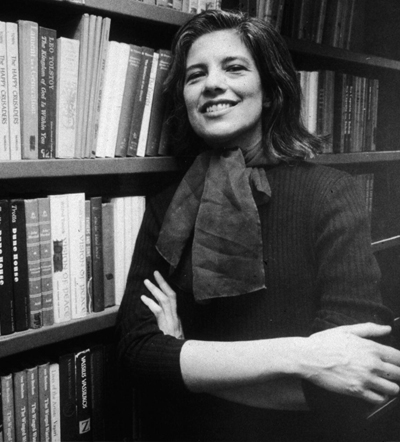
Susan Sontag. Photo: New York Times Co./Archive Photos/Getty/Courtesy of HBO

What has happened to the public intellectual? When Susan Sontag died in 2004, after losing her third battle with cancer, it seemed as though not only a majestic woman but a twentieth century tradition had died. Who in public life now has Sontag’s uncompromising verve, her endless curiosity, her willingness to plunge headlong into both intellectual theory and artistic practice?
Granted, during her lifetime Sontag could be the butt of jokes—and she could also be a bit of a pain. Her name was often invoked as a byword for “something intellectual you probably don’t understand,” used in movies from Bull Durham to Gremlins 2. She was tone-deaf after 9/11, insisting the hijackers had legitimate cause. Even the writer Wayne Koestenbaum, one of her most ardent fans, admits that “she represents grandiosity, I think, and it is a little comic…because it seems a bit of a pose.”
That quote, and many other revealing ones about Sontag, occur in Nancy Kates’ fascinating HBO documentary Regarding Susan Sontag (debuting Monday December 8), where we find out a lot about Sontag as both public figure and private individual. We learn about her huge intellectual appetite, her ambivalence about being gay and Jewish, and the beauty that made everyone from Henri Cartier-Bresson to Andy Warhol want to photograph her.
(more…)
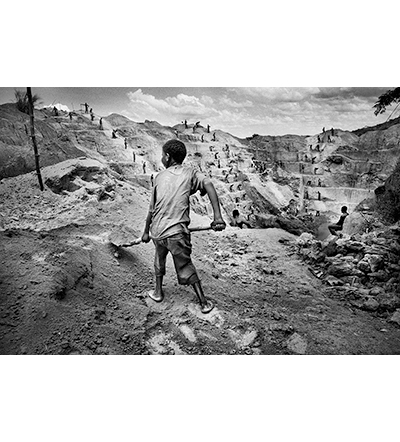
Marcus Bleasdale

For those of us not directly caught up in war, it’s easy to think it as something distant and isolated, an abstraction of bomb blasts, tanks and tents. Of course, though, war is anything but impersonal. Especially in our new century, it often takes place in populated areas and involves substantial collateral damage. Towns are razed, innocents killed, and survivors left with a burden of trauma and guilt.
Knowing this, the best photographers approach war as a human-interest story. It’s an uncomfortable truth that war photography has flourished in the last two decades, with a generation of sensitive young photographers taking the baton from their celebrated predecessors. Among the best are people like Marcus Bleasdale, Paolo Pellegrin, Peter van Agtmael and Tim Hetherington—all of whose work is featured in the moving new book and exhibition, A Form of Love.
The title comes from a quote by writer Sebastian Junger, known for his collaborations with Tim Hetherington. “The willingness to die for another person is a form of love that even religions fail to inspire, and the experience of it changes a person profoundly,” Junger writes. Indeed, in these images we see evidence of soldiers’ love, both in quiet moments and at tragic junctions where they’re trying to save each others’ lives.
(more…)
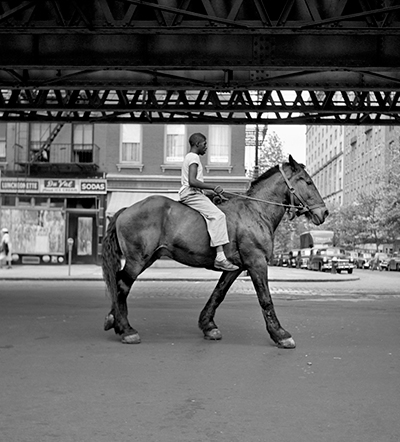

Vivian Maier’s photography has had a seismic effect on the art world since it was discovered a few years ago. The poignant story behind the work enhances its appeal: Maier was one of the finest street photographers of the mid-twentieth century, yet she kept her work hidden and died in poverty. In fact, she worked as a nanny for her entire career, living with a succession of suburban families and becoming increasingly eccentric. Her employers knew her as a shutterbug, but it was only after her death that the amazing quality and breadth of her work was discovered.
Maier’s photography, and her fascinating story, would never have come to light if not for John Maloof, a young Chicagoan who happened across a trunk of her negatives at a local auction house. In the absorbing new documentary Finding Vivian Maier, Maloof traces the story of his find, and the obsessive quest he went on to solve the mystery behind the treasure trove of images Maier left behind.
The film, which is both unsettling and delightful, offers a compelling, bittersweet portrait of a very complicated woman. A veritable Mary Poppins figure to some of the children she worked with, Maier was abusive to others. She was extremely wary of men, in a way that suggested she might have been abused herself. Often she refused to give her name and occupation to people, referring to herself as “the mystery woman” or “a kind of spy.”
(more…)
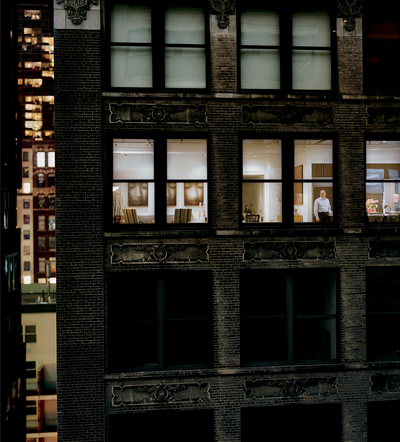
From Out My Window by Gail Albert Halaban, published by powerHouse Books

If you live in a city, in a place where you can look into other people’s windows through your own, it may be irresistible to indulge your voyeuristic impulses. We all love mysteries, and what could be more mysterious than a parallel life witnessed in glimpses through glass? Just ask Jeff Jeffries, the character played by James Stewart in Hitchcock’s masterful
Rear Window. Laid up at home with a broken leg, Jeffries gets so involved with his Greenwich Village neighbors that he gives them inventive nicknames like “Miss Torso.”
With its crowded-together buildings and social diversity, New York City is the perfect locus for a film like Rear Window, or the similarly voyeuristic Dirty Windows, photographer Merry Alpern’s 1995 book of images secretly shot through the window of a low-rent sex club. But not everything going on through those neighboring windows is tacky or suspicious. Witness Gail Albert Halaban’s beautiful new book Out My Window (powerHouse), a warm and lyrical study of New Yorkers and their windowscapes.
Slideshow
(more…)
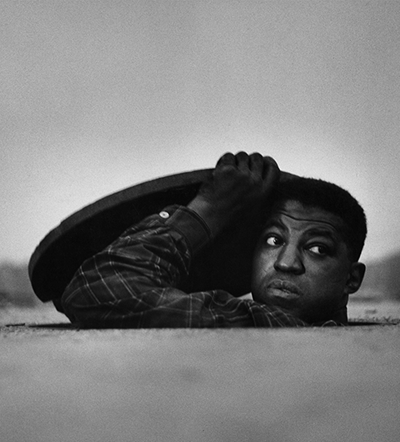
The Invisible Man, Harlem, New York, 1952. Gelatin silver print

“I am an invisible man,” begins Ralph Ellison’s famous 1952 novel, in an opening that rivals “Call me Ishmael” and “Lolita, light of my life” for its compact resonance. The narrator of
Invisible Man goes on to say that he’s “not a spook like those that haunted Edgar Allan Poe; nor am I one of your Hollywood movie ectoplasms.” Instead, his invisibility is caused by race: being a black man in 1950s America makes him a blank canvas onto which people’s fears and anxieties are projected.
How do you photograph an invisible man? That was the challenge Gordon Parks took up in 1952, when Invisible Man was published. At that time, Parks himself was a highly visible black man. He’d broken through race barriers to become the first African-American staff photographer at Life magazine, and had written his own prose and poetry. He’d made an enduring and iconic portrait, American Gothic, in which a dignified cleaning woman symbolizes the shabby treatment of blacks in America.
The soulful images Parks produced, with inspiration from Ellison’s novel, are the subject of an intriguing exhibition, Contact: Gordon Parks, Ralph Ellison and ‘Invisible Man’ at the Howard Greenberg Gallery. At the time he made this work, Parks had just won a plum assignment to work in Paris for Life. He was leading a cosmopolitan life of glamor–but his passion and empathy for Harlem shines bright and clear in his Invisible Man series.
(more…)
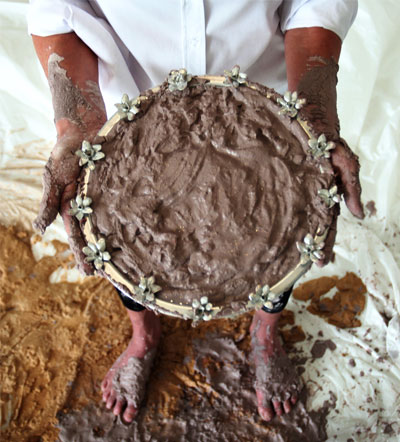
Texas Mud Pie, Hands and Feet (self-portrait), 2012 C-print

Are the Internet and social media making us more, or less social? Smarter or dumber? Are you going to make it through this review before clicking over to check your email, Twitter account, Facebook page, or blog site? How many people “liked” your status update today?
Artist Rachel Lee Hovnavian is fascinated by the social transformations wrought by the virtual world. Mud Pie, her new show at the Leila Heller Gallery, is all about how we seem increasingly happy to forgo real experience in favor of the virtual and artificial. This could be a dry, heavy-handed message, but Hovnavian delivers it with such sly humor and visual panache that even the most committed technophiles might have to admit she’s on to something.
Take the show’s centerpiece, a supposedly romantic dinner for two. A long dining table is elegantly set with all the expected signifiers: flowers, candles, wineglasses. But the couple itself is virtual, represented by two LCD screens. The man and woman on the screens don’t speak to each other. Instead, each seems perfectly satisfied to interact with a mobile device while beeps, trills and the Angry Birds soundtrack punctuate the silence. Oh, and those flowers? They’re artificial. Naturally.
Slideshow
(more…)
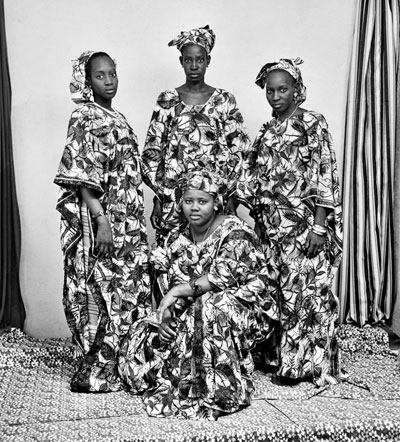
Studio Malick, Bamako, 16 and 17 September 1977 © Malick SidibÈ

When we see photographs from Africa, they’re often dispatches from war or famine zones. It’s a sad truth that there are enough “hot spots” in Africa to supply us with a steady stream of such images for many years to come. But there are happier sides to Africa too, some of which have been documented by native photographers like Malick Sidibé.
Sidibé, who was born in the 1930s, has spent a long career taking portraits of his fellow citizens in Bamako, Mali. Up until recently, few Malian families could afford to buy cameras, so it was customary for people to visit a studio photographer when they wanted to document something significant–from the birth of a baby to a new hairstyle or motorbike. In Sidibé’s portraits you see pride and a sense of occasion, but there’s also a playfulness in the way he gets his subjects to pose, shirt-sleeves rolled up, sunglasses covering their eyes, mimicking styles from the covers of magazines and pop music albums.
Slideshow
(more…)
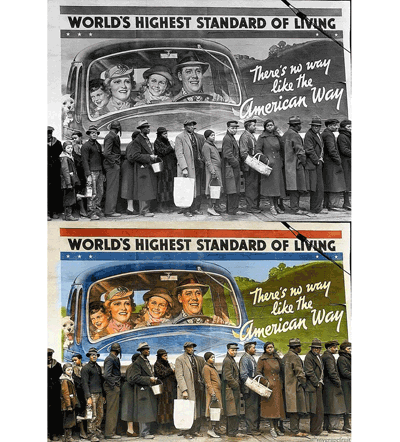
Margaret Bourke-White's 1937 Bread Line during the Louisville Flood. All images colorized by Sanna Dullaway.

This week, Sanna Dullaway’s colorized versions of famous historic photographs went viral on the Internet, drawing both admiration and alarm. Dullaway had picked some truly iconic photographs to colorize, from Dorothea Lange’s Migrant Mother to Eddie Adams’ famous shot of a Vietnamese general executing a Vietcong prisoner during the opening stages of the Tet Offensive. The young Swede (who has just launched a business colorizing old family snapshots) displayed these color versions side-by-side with the originals. Suddenly, figures and scenes long burned into our minds in their original black-and-white incarnations were popping out in glorious color—rusty reds, rich golds, the blue of cornflowers and irises. The images spread quickly on news sites and Facebook feeds—and then some people got mad.
“A parasitical one trick pony grazing on the shoulders of giants,” Dullaway was called in one Facebook photography thread, while someone else excoriated her for “coloring that like a coloring book.” “Sickening” and “inexcusable” were other adjectives thrown out. Some were more generous, admiring Dullaway’s technique and color choices, and writing that it had given them a new appreciation of the original work.
I was intrigued by this response, and by the protectiveness people felt toward these images. Personally I found them fascinating, and not confusing or deceptive since they were printed side-by-side with the original black-and-whites.
(more…)

Berenice Abbott, Zito’s Bakery, 259 Bleecker Street , 1937, from Changing New York, 1935–39, gelatin silver print. The Jewish Museum, New York, Purchase: Mimi and Barry J. Alperin Fund

Small, light and fast, the Leica was the cellphone camera of its day. When it launched in the 1920s, professional photographers took to the streets with it and captured quick, spontaneous images that hadn’t been possible with their lumbering view cameras. Perhaps no group used the camera better in its early days than the New York Photo League, a ragtag band of urban photographers who were equally passionate about politics and aesthetics. In the 1930s and 40s, their documentation would provide a vibrant record of everyday life in New York City.
The Radical Camera: The New York Photo League 1936-1951, now at the Jewish Museum, pays tribute to the ninety-some photographers involved in this short-lived, feisty little organization. Notably, most Photo League members came from modest backgrounds (a lot were first-generation American Jews). Their aim was to throw light on their own poor neighborhoods and others, and by doing so, to effect social change. Not for them the beautiful, static landscapes being captured by Ansel Adams in the same years; instead, they turned their lenses on the teeming streets of the Lower East Side and Harlem, where children played in abandoned buildings and garbage littered the streets.
Slideshow
(more…)

Paul Cadmus, 1928, by Luigi Lucioni (American, 1900–1988)

Thanks to popular television shows like HBO’s
Boardwalk Empire and Ken Burns’ new PBS documentary series
Prohibition, we’re well informed about what went on socially and politically in the 1920s, from the rise of the Mafia to the new freedoms women enjoyed as voters and flappers. But what about visual art? What did painters, sculptors and photographers produce during the ten years between the Great War and the Great Depression?
Youth and Beauty (Skira Rizzoli), a beautiful coffee-table book accompanying an exhibition opening at the Brooklyn Museum in October, gives plentiful answers to that question. Of course, we know what happened artistically in postwar Europe: it was the Golden Age of Modernism, when artists like Picasso, Mondrian and Kandinsky were producing some of their best work. Newly mature, Modernism bore its own wild children–Dada, Surrealism and Futurism among them.
(more…)





 Facebook
Facebook Permalink
Permalink Digg
Digg Reddit
Reddit LinkedIn
LinkedIn StumbleUpon
StumbleUpon Tumblr
Tumblr










